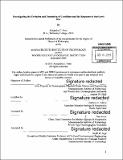| dc.contributor.advisor | Andrew D. Ashton. | en_US |
| dc.contributor.author | Ortiz, Alejandra C | en_US |
| dc.contributor.other | Woods Hole Oceanographic Institution. | en_US |
| dc.date.accessioned | 2016-03-25T13:39:08Z | |
| dc.date.available | 2016-03-25T13:39:08Z | |
| dc.date.copyright | 2015 | en_US |
| dc.date.issued | 2015 | en_US |
| dc.identifier.uri | http://hdl.handle.net/1721.1/101835 | |
| dc.description | Thesis: Ph. D., Joint Program in Oceanography/Applied Ocean Science and Engineering (Massachusetts Institute of Technology, Department of Civil and Environmental Engineering; and the Woods Hole Oceanographic Institution), 2015. | en_US |
| dc.description | Cataloged from PDF version of thesis. | en_US |
| dc.description | Includes bibliographical references. | en_US |
| dc.description.abstract | To understand how waves and sea level shape sandy shoreline profiles, I use existing energetics-based equations of cross-shore sediment flux to describe shoreface evolution and equilibrium profiles, utilizing linear Airy wave theory instead of shallow-water wave assumptions. By calculating a depth-dependent characteristic diffusivity timescale, I develop a morphodynamic depth of shoreface closure for a given time envelope, with depth increasing as temporal scale increases. To assess which wave events are most important in shaping the shoreface in terms of occurrence and severity, I calculate the characteristic effective wave conditions for both cross-shore and alongshore shoreline evolution. Extreme events are formative in the cross-shore shoreface evolution, while alongshore shoreline evolution scales linearly with the mean wave climate. Bimodal distributions of weighted wave heights are indicative of a site impacted more frequently by tropical storms rather than extra-tropical storms. To understand how offshore wave climate and underlying geometry of a carbonate reef platform shapes evolution of atolls, I simulate the hydrodynamics of a simplified reef flat, using XBeach, a two-dimensional model of infragravity wave propagation. The reef flat self-organizes to a specific width and water depth depending on the offshore wave climate and characteristics of the available sediment. Formation of a sub-aerial landmass, like a motu, can be initiated by a change in offshore wave climate (like a storm), which can create a nucleation site from mobilization and deposition of coarse sediment on the reef flat. Once a motu is present, the shoreline should prograde until reaching a critical reef-flat width. Our conceptual model of reef-flat evolution and motu formation is governed by understanding the hydrodynamics of the system and subsequent response of sediment transport. | en_US |
| dc.description.statementofresponsibility | by Alejandra C. Ortiz. | en_US |
| dc.format.extent | 132 pages | en_US |
| dc.language.iso | eng | en_US |
| dc.publisher | Massachusetts Institute of Technology | en_US |
| dc.rights | M.I.T. theses are protected by copyright. They may be viewed from this source for any purpose, but reproduction or distribution in any format is prohibited without written permission. See provided URL for inquiries about permission. | en_US |
| dc.rights.uri | http://dspace.mit.edu/handle/1721.1/7582 | en_US |
| dc.subject | Joint Program in Oceanography/Applied Ocean Science and Engineering. | en_US |
| dc.subject | Civil and Environmental Engineering. | en_US |
| dc.subject | Woods Hole Oceanographic Institution. | en_US |
| dc.subject.lcsh | Coral reefs and islands | en_US |
| dc.subject.lcsh | Ocean waves | en_US |
| dc.title | Investigating the evolution and formation of coastlines and the response to sea-level rise | en_US |
| dc.type | Thesis | en_US |
| dc.description.degree | Ph. D. | en_US |
| dc.contributor.department | Joint Program in Oceanography/Applied Ocean Science and Engineering | en_US |
| dc.contributor.department | Woods Hole Oceanographic Institution | en_US |
| dc.contributor.department | Massachusetts Institute of Technology. Department of Civil and Environmental Engineering | |
| dc.identifier.oclc | 941806933 | en_US |
